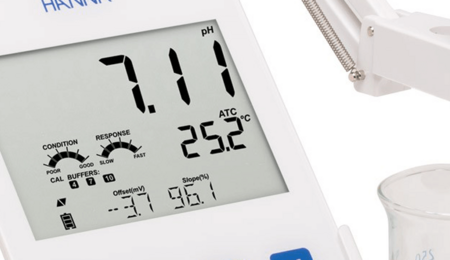Understanding and Measuring pH

This is a question that usually makes new growers scratch their heads and reach for the pipe. pH applies to the level of alkalinity or acidity of a given “thing”, in this case a liquid. The liquid is the nutrient solution being used to grow your green. The pH scale starts at 0 and rises to 14. A value of 7.0 is considered neutral, with values over 7.0 being alkaline and values below 7.0 being acidic. The question that must be asked is why this is important.
What’s pH?
The nutrient solution is basically a cocktail of various chemicals. These chemicals can react to each other in a process called covalent bonding and form new chemicals that aren’t wanted. They’re not wanted because the plant can’t use them. This process of covalent bonding is largely dependent on the pH of the solution the chemicals are suspended in, in this case water. With the chemicals being used in your average hydroponic solution, a chemist would say that the optimum pH would be 7.0, which is neutral. The reasoning behind this is that in keeping the solution neutral, covalent bonding of the constituent parts of your solution will be kept to a minimum. But since cannabis plants like a different pH level for optimum growth, lower the pH, and take the slight loss of nutrient value.
Fast growing leafy plants generally like a lower pH in the range of 5.2 to 5.9. Fortunately, a lower pH will bond fewer nutrients than will a higher pH. If the pH value goes beyond the optimum range of 5.2 to 5.9, undesirable levels of nutritional deficiency and toxicity will occur, both of which can seriously impede plant growth. Be vigilant. In researching the various hydroponic methods in use, it might have been noticed that most of the growing media in use is relatively inert (rockwool, pea gravel, sand, etc.). That is, the growing medium won’t react with the nutrients in the solution. For those methods that use inert media, a pH of 5.2 is recommended for optimal elemental uptake. It is at this pH level that the roots will assimilate the nutrients in the solution most efficiently. If the root has to work less to assimilate the required nutrients, the rest of the plant will benefit.
Measuring pH
Measuring pH is relatively easy, and there are quite a few choices in terms of methods. The most inexpensive and low-tech method entails taking a sample from the nutrient solution. It is put into a clean vial you get with the pH kit. Test for the pH by putting a drop of the something-or-other liquid that came in the kit into the vial (NOT the solution). The something-or-other makes the nutrient solution turn color, usually shades of green or blue-green. This color is then compared to a color chart that comes with the kit. The closest color is the pH of the solution. This low-tech solution poses some obvious limitations, not the least of which is the difficulty in deciding which color is closest if you’ve been into the fruits of your previous harvest. The kits sell for 5 to 10 dollars.
Adjusting pH
Knowing what chemical to add to the nutrient solution and when is paramount to success as a grower. When the pH level is too high (alkaline), it can be lowered with saltpeter, sulfuric acid or phosphorous. When the pH value is too low, it can be raised with calcium carbonate, lime or, potash. Most fertilizers cause a pH change in the nutrient solution. Adding fertilizer to the nutrient solution almost always results in a more acidic pH. Adjust accordingly. The proper way to handle all of these chemicals is important. The first general rule is don’t do it when you’re high. Just don’t do it – the plants can miss a feeding if necessary. Another general rule is to use glass or plastic, never metal. The nutrients will react with the very free elements in the metal and mess up the nutrient ratios. Glass or plastic doesn’t have that problem, so get to the kitchen section of the nearest department store first. Never add the acid to the vat of nutrient. Fill a small glass container with the nutrient to be balanced and add a few drops of the necessary chemical. Stir it in well and add small amounts at a time to the large vat of nutrient until the proper pH balance is achieved. That’s all there is to it. As time goes on, the amount of salts produced by the breakdown of fertilizers in the medium causes it to become increasingly acidic.
Eventually, the concentration of these salts in the medium will stunt the plant and cause browning out of the foliage. Also, as the plant gets older its roots become less effective in bringing food to the leaves. To avoid the accumulation of these salts in your medium and to ensure that the plant is getting all of the food it needs, be sure to flush the system with clean, pH balanced water every couple of weeks. Do this in lieu of that cycle’s feeding. There’s always been a big debate over when to adjust your pH – before and after you add nutrients to the water, or just after. We talked to an expert, and she said to do both. The reasoning for doing both is that water is rarely dead on neutral. It’s either acidic or alkaline, depending on your region. Our chemist said that the way the professionals do it is to render the water neutral first (pH of 7.0). You would then add your nutrients to that chemically neutral solution and adjust to the desired range within 5.2 to 5.9 pH. Makes sense.



